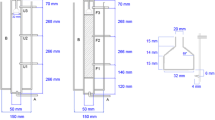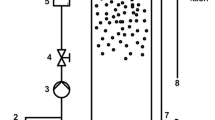Abstract
This contribution deals with a novel anaerobic–anoxic reactor for biological nutrient removal (BNR) from wastewater, termed AnoxAn. In the AnoxAn reactor, the anaerobic and anoxic zones for phosphate removal and denitrification are integrated in a single continuous upflow sludge blanket reactor, aiming at high compactness and efficiency. Its application is envisaged in those cases where retrofitting of existing wastewater treatment plants for BNR, or the construction of new ones, is limited by the available surface area. The environmental conditions are vertically divided up inside the reactor with the anaerobic zone at the bottom and the anoxic zone above. The capability of the AnoxAn configuration to establish two hydraulically separated zones inside the single reactor was assessed by means of hydraulic characterization experiments and model simulations. Residence time distribution (RTD) experiments in clean water were performed in a bench-scale (48.4 L) AnoxAn prototype. The required hydraulic separation between the anaerobic and anoxic zones, as well as adequate mixing in the individual zones, were obtained through selected mixing devices. The observed behaviour was described by a hydraulic model consisting of continuous stirred tank reactors and plug-flow reactors. The impact of the denitrification process in the anoxic zone on the hydraulic separation was subsequently evaluated through model simulations. The desired hydraulic behaviour proved feasible, involving little mixing between the anaerobic and anoxic zones (mixing flowrate 40.2 % of influent flowrate) and negligible nitrate concentration in the anaerobic zone (less than 0.1 mgN L−1) when denitrification was considered.







Similar content being viewed by others
References
Vlekke GJFM, Comeau Y, Oldham WK (1988) Biological phosphate removal from wastewater with oxygen or nitrate in sequencing batch reactors. Environ Technol Lett 9:791–796
Kuba T, Smolders G, van Loosdrecht MCM, Heijnen JJ (1993) Biological phosphorus removal from wastewater by anaerobic-anoxic sequencing batch reactor. Water Sci Technol 27(5/6):241–252
Ahn KH, Song KG, Cho E, Cho J, Yun H, Lee S, Kim J (2003) Enhanced biological phosphorus and nitrogen removal using a sequencing anoxic/anaerobic membrane bioreactor (SAM) process. Desalination 157(1–3):345–352
Song KG, Cho J, Cho KW, Kim SD, Ahn KH (2010) Characteristics of simultaneous nitrogen and phosphorus removal in a pilot-scale sequencing anoxic/anaerobic membrane bioreactor at various conditions. Desalination 250(2):801–804
Song KG, Cho J, Ahn KH (2009) Effects of internal recycling time mode and hydraulic retention time on biological nitrogen and phosphorus removal in a sequencing anoxic/anaerobic membrane bioreactor process. Bioprocess Biosyst Eng 32:135–142
Kwon JC, Park HS, An JY, Shim KB, Kim YH, Shin HS (2005) Biological nutrient removal in simple dual sludge system with an UMBR (upflow multi-layer bio reactor) and aerobic biofilm reactor. Water Sci Technol 52(10–11):443–451
Tejero I, Díez R, Esteban AL, Lobo A, Temprano J, and Rodríguez L (2010) Reactor biológico anóxico-anaerobio para la eliminación de nutrientes de aguas residuales (Anoxic-anaerobic biological reactor for nutrient removal from wastewater). Spanish Patent ES2338979 (in Spanish)
Lettinga G, van Velsen AFM, Hobma SW, de Zeeuw WJ, Klapwijk A (1980) Use of the upflow sludge blanket (USB) reactor concept for biological wastewater treatment. Biotechnol Bioeng 22:699–734
Tchobanoglous G, Burton FL, Stensel HD (2003) Wastewater engineering: treatment and reuse, 4th edn. Metcalf Eddy, McGraw-Hill
Olivet D, Valls J, Gordillo MA, Freixó A, Sánchez A (2005) Application of residence time distribution technique to the study of the hydrodynamic behaviour of a full-scale wastewater treatment plant plug-flow bioreactor. J Chem Technol Biotechnol 80:425–432
Hu B, Wheatley A, Ishtchenko V, Huddersman K (2012) Performance linked to residence time distribution by a novel wool-based bioreactor for tertiary sewage treatment. Appl Microbiol Biot 94:817–828
Yerushalmi L, Alimahmoodi M, Behzadian F, Mulligan CN (2013) Mixing characteristics and liquid circulation in a new multi-environment bioreactor. Bioprocess Biosyst Eng 36:1339–1352
Fall C, Loaiza-Navía JL (2007) Design of a tracer test experience and dynamic calibration of the hydraulic model for a full-scale wastewater treatment plant by use of Aquasim. Water Environ Res 79(8):893–900
Sarathai Y, Koottatep T, Morel A (2010) Hydraulic characteristics of an anaerobic baffled reactor as onsite wastewater treatment system. J Environ Sci 22(9):1319–1326
Gómez C (2010) Desarrollo y modelización de un sistema biopelícula para la eliminación de materia orgánica y nitrógeno (Development and modelling of a biofilm system for organic matter and nitrogen removal). Ph.D. diss., University of Cantabria, Santander (in Spanish)
Ji JY, Zheng K, Xing YJ, Zheng P (2012) Hydraulic characteristics and their effects on working performance of compartmentalized anaerobic reactor. Bioresour Technol 116:47–52
Behzadian F, Yerushalmi L, Alimahmoodi M, Mulligan CN (2013) Hydrodynamic characteristics and overall volumetric oxygen transfer coefficient of a new multi-environment bioreactor. Bioprocess Biosyst Eng 36:1043–1052
Zeng Y, Mu SJ, Lou SJ, Tartakovsky B, Guiot SR, Wu P (2005) Hydraulic modeling and axial dispersion analysis of UASB reactor. Biochem Eng J 25(2):113–123
Nemade PD, Dutta SM, Shankar HS (2010) Residence time distribution and oxygen transfer in a novel constructed soil filter. J Chem Technol Biot 85:77–84
Hartley K (2013) Tuning biological nutrient removal plants. IWA Publishing, London
Levenspiel O (1999) Chemical reaction engineering, 3rd edn. Wiley, New York
Tang D, Jess A, Ren X, Bluemich B, Stapf S (2004) Axial dispersion and wall effects in narrow fixed bed reactors: a comparative study based on RTD and NMR measurements. Chem Eng Technol 27(8):866–873
Martin-Dominguez A, Tzatchkov VG, Martin-Dominguez IR, Lawler DF (2005) An enhanced tanks-in-series model for interpretation of tracer tests. J Water Supply Res T 54:435–448
Reichert P (1994) Aquasim—a tool for simulation and data-analysis of aquatic systems. Water Sci Technol 30(2):21–30
Henze M, Gujer W, Mino T, Matsuo T, Wentzel MC, Marais GVR, Van Loosdrecht MCM (1999) Activated sludge model no. 2d, ASM2d. Water Sci Technol 39:165–182
Water Environment Federation (2010) Nutrient removal, WEF manual of practice no. 34. WEF Press, Alexandria
Heertjes PM, Van Der Meer RR (1978) Dynamics of liquid flow in an up-flow reactor-used for anaerobic treatment of wastewater. Biotechnol Bioeng 20(10):1577–1594
Lou SJ, Tartakovsky B, Zeng Y, Wu P, Guiot SR (2006) Fluorescence-based monitoring of tracer and substrate distribution in an UASB reactor. Chemosphere 65:1212–1220
Ren TT, Mu Y, Yu HQ, Harada H, Li YY (2008) Dispersion analysis of an acidogenic UASB reactor. Chem Eng J 142:182–189
Acknowledgments
The Spanish Ministries of Education and Science and of Economy and Competitiveness funded our research activity through the projects NOVEDAR (CSD2007-00055), HIBREDAR (CTM2008-06877-C02-01_TECNO), and PBi2 (CTM2012-36227), the latter being co-financed by the European Regional Development Fund. The authors also thank Amaya Lobo and Claudio Gómez for their helpful comments and suggestions.
Author information
Authors and Affiliations
Corresponding author
Rights and permissions
About this article
Cite this article
Díez-Montero, R., De Florio, L., González-Viar, M. et al. Feasibility of hydraulic separation in a novel anaerobic–anoxic upflow reactor for biological nutrient removal. Bioprocess Biosyst Eng 38, 93–103 (2015). https://doi.org/10.1007/s00449-014-1247-9
Received:
Accepted:
Published:
Issue Date:
DOI: https://doi.org/10.1007/s00449-014-1247-9




